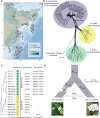Transition to Self-compatibility Associated With Dominant S-allele in a Diploid Siberian Progenitor of Allotetraploid Arabidopsis kamchatica Revealed by Arabidopsis lyrata Genomes
- PMID: 37432770
- PMCID: PMC10335350
- DOI: 10.1093/molbev/msad122
Transition to Self-compatibility Associated With Dominant S-allele in a Diploid Siberian Progenitor of Allotetraploid Arabidopsis kamchatica Revealed by Arabidopsis lyrata Genomes
Abstract
A transition to selfing can be beneficial when mating partners are scarce, for example, due to ploidy changes or at species range edges. Here, we explain how self-compatibility evolved in diploid Siberian Arabidopsis lyrata, and how it contributed to the establishment of allotetraploid Arabidopsis kamchatica. First, we provide chromosome-level genome assemblies for two self-fertilizing diploid A. lyrata accessions, one from North America and one from Siberia, including a fully assembled S-locus for the latter. We then propose a sequence of events leading to the loss of self-incompatibility in Siberian A. lyrata, date this independent transition to ∼90 Kya, and infer evolutionary relationships between Siberian and North American A. lyrata, showing an independent transition to selfing in Siberia. Finally, we provide evidence that this selfing Siberian A. lyrata lineage contributed to the formation of the allotetraploid A. kamchatica and propose that the selfing of the latter is mediated by the loss-of-function mutation in a dominant S-allele inherited from A. lyrata.
Keywords: Arabidopsis kamchatica; Arabidopsis lyrata; S-locus; allopolyploidy; self-compatibility.
© The Author(s) 2023. Published by Oxford University Press on behalf of Society for Molecular Biology and Evolution.
Figures




References
-
- Ayala D, Guerrero RF, Kirkpatrick M. 2013. Reproductive isolation and local adaptation quantified for a chromosome inversion in a malaria mosquito. Evolution. 67:946–958. - PubMed
-
- Bachmann JA, Tedder A, Laenen B, Fracassetti M, Désamoré A, Lafon-Placette C, Steige KA, Callot C, Marande W, Neuffer B, et al. . 2019. Genetic basis and timing of a major mating system shift in Capsella. New Phytol. 224:505–517. - PubMed
Publication types
MeSH terms
Grants and funding
LinkOut - more resources
Full Text Sources

